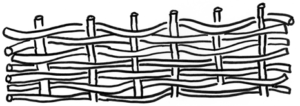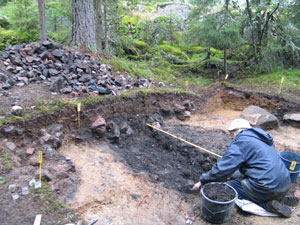Habitation
In the house live my folks; great grandfather, my wife Kaarnikka, my children Ohto, Leinikka, Saarno and little Ilmi. Behind the forest lives my brother Jousia with his young bride. Our family has lived in this area for a long time. It is good to be here and it is good to live here. Our house is steadily standing in the sands. The days warm us here. The cliffs protect from cold winds blowing from the north and the east, and the turf walls keep the freezing cold away. The roof is supported by poles. The sand floor has been trampled by many steps.
The gods were not favourable when the house was built. A fire almost broke out when a wind flurry threw a burning firebrand to the reeds which were collected for building the roof. We got the fire extinguished at the last moment. It was very close that the turf walls would have caught fire. The gods needed to be propitiated. To prevent another fire we transferred the fire which had burned the tips of the poles away next to a big rock to be safe from strong winds. The poles have been standing well since then, but new reeds need to be bound to the roof next summer.
I walk around the yard. Everything is in place. The punt is pulled to shore. The fishing nets are drying up next to it. Leafy branches have been stored for winter. I bow to get inside the dusky house. A dog is following me. The glowing stones of the stove are still warming. My folks are sleeping in their own berths. The wind is shaking the reed roof. I fall asleep to that voice.

The dwelling place of the people buried in the stone cairns of Sammallahdenmäki during the Bronze Age has not been found to date. However, in the beginning of the Iron Age there have been settlements right to the southeast from the graves, in Huilu and Tahtmaa in Kivikylä, and it is highly likely that also their ancestors lived in the vicinity of the burial cairns. The dwelling sites were carefully chosen. The sandy slopes in the south side were warm and it was easy to erect pole-supported houses there. Also, in rainy times the sand passed the water keeping the houses and the yards dry. There needed to be drinking water, fishing waters, suitable lands for agriculture and forests as well as shore meadows for livestock close to the settlements.
In the dwelling site of Huilu excavations have revealed that there has been a building 16m long and 6-7,5m wide with a stove in its north-western end. The house has been supported by poles, some of which were supported by rocks. Only very small amounts of burnt clay seal has been found in Huilu which indicates that it is possible that the house had turf walls. However, it can also be that the house was never burnt but was moved to another place instead which would also explain the lack of clay. The walls could have also been built of branches using clay as a sealant. Clay became especially good sealant if it was mixed with manure. Another possibility for building the walls was to fill the space between parallel vertical poles with branches – these walls needed to be sealed as well. The reed that could be collected from the shores of the sea and the lakes was good building material for the roofs. In addition to actual houses, round-shaped huts were used as well at the time.
The hearths that were dug in the ground could have been paved in order to make them to store heat and thus to generate warmth for a longer time. The pit stoves over a meter deep and over two meters in diameter found in Tahtmaa contained carbon and burnt stones in abundance, but their purpose remain unknown for the time being. Often there are several pits close to each other and it has been suggested that they were used to melt seal fat or to dry or sour meat. They resemble “robber steak pits” which still today are used to stew meat.

Visible remains of everyday human life in the dwelling sites can be found in the so called dirt land which contains shreds of pottery, stone artefacts and burnt animal bones. The earth within the yard and the buildings is often compact as a result of human trampling. In addition to the hearths, pole prints and burnt clay there is hardly anything remaining of the buildings that once stood there.